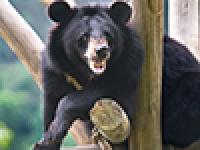The horror continues
09 February 2009, 00:00AM
Despite our new bears having better body condition than those we received last March, the emergency health-checks are showing all too clearly the problems that the bear farmers are attempting to disguise.
The paws of nearly all in this group are hyperkeratotic (cracked and dry with painful “pebble-like” formations on their normally soft pads). Deep cage-bar indentations clearly seen on many of the pads show how they “rocked” each day in stereotypic motions; aimlessly, monotonously for hours and hours, in the same position on the bars, as the years wore on.
Most have horrendous teeth problems – with canines cut flat against their gums exposing pulp and nerves – or cracked and shattered where they have bitten on the bars of their cage in frustration for years or decades.
The smell from their mouths is appalling – but it’s not this that makes us feel sick. It’s the fact that they have endured the most searing pain in their teeth every time they have tried to eat. No wonder so many of them are thin.
Bears like poor Louis who had cavernous holes in his canines – black and rotting inside – with one grotesque hole obscenely packed with six decaying pumpkin seeds that were lodged in the cavity.


Several of the bears have free-drip sites – open and oozing bile and pus. Many have two fistula sites in their abdomens. Here the farmer has been unable to extract bile from one hole which has desperately tried to heal, and has called in a so-called surgeon who has crudely cut into the bears’ abdomen again with as much thought as if he were using a hole-punch on a card.
Many have joint problems – you can hear their elbows, knees and hips clicking on manipulation when vets Heather, Leanne and Faithe go through the mobility check-list and find that youngsters who should have pliable, flexible joints have the limbs of old, arthritic bears.
Other bears laid out in health-checks have horribly curved spines where they lay curled in cages their whole lives. Luckily we have a good deal of experience in relation to treatment of such bears since starting the rescue in October 2000. Old and young animals before these have been given various combinations of drugs so that today we can stave off problems that should be affecting them well into old age, rather than now.
But when they wake up in their recovery cages it makes you glow with joy. Slowly coming around from their anaesthetic, you see them stretching their limbs to the point where the bars of their old prisons used to be. Then they begin to realise that something has changed and, in an anaesthetic stupor, they continue stretching wobbly limbs further and further out – to the point where they can stretch properly for the first time in their lives.
Colin made us gulp back tears yesterday as we saw him standing up after the anaesthetic had worn off. He realised that he had a bowl full of food at the end of his cage, but seemed to be concerned that the size of his new home would reduce again if he moved his whole body over to his food to eat. So he skilfully manoeuvred himself so that his head and mouth could reach the food, while one of his back feet stretched out behind him and rested against the back of the cage.
Bear manager Donata snapped this heartbreaking photo of Colin coming to terms with the extra space in his cage:

Similarly, they now have straw where a bed has never been. Bedding-down had never been an option for these animals that are simply seen as a “resource” for farmers who wouldn’t spend a cent on anything like basic care.
Hamster is a bear Leanne and I nicknamed yesterday. She had told me that he loved straw, but didn’t seem to realise what it was for. I joined her as he pulled it down from the roof of his recovery cage – strand by laborious strand, in what seemed like the whole afternoon, before he finally made a bed and then immediately curled up like a hamster and fell asleep.
Here is Hamster arriving on the truck:



And here he is yesterday during his health-check, which found this horrendously painful ingrown claw. Poor Hamster likes to lie on his back – we guess because he wants to avoid putting pressure on his paws.



For now, as our 12 bears lay snug and warm and full to the brim with good food, I think it’s no coincidence that it’s three years to the day since we lost our beloved Andrew, our first ever bear, to liver cancer. This is the bear that saw David, a supporter in the UK, writing to us after he died and saying, “We are not weaker without Andrew but stronger because of him”. And here, as our new bears wake up to each day without fear, suffering or pain, I like to think that Andrew, our sleeping giant, would be smiling for their new lives.
Recent Posts
Festive fun at our sanctuaries
December 19, 2024

